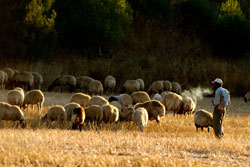Disease resistance genes tracked in sheep
Meat, wool and milk are important products in the sheep industry. Particularly important in marginal hillside and mountainous regions of Europe, sheep products form the backbone of rural community economies. Unfortunately, sheep are prey to a wide range of pathologies and parasites. One notable and common parasite is the larval stage of Oestrus ovis, a fly that lays its eggs near the nasal passages of sheep. These then hatch into larvae that feed on the tissue in the nasal and sinus passages of the infected animal. The resultant disease, commonly known as botfly, causes distress in the animal and behaviour such as head shaking. Commercially, the effect is loss of milk, meat yield and poor fleece quality. Treatment is difficult but insecticides and biological intervention by the release of sterile male flies are available remedies. The objective of the EC funded GENESHEEPSAFETY, as the name suggests, was to ensure the safety and quality of food produced from sheep flocks. Research partners at the National Veterinary School of Toulouse, France studied the genome of this damaging parasite. High on their list of objectives was to find the genes or quantitative trait loci (QTL) responsible for resistance. One feature of the pathology of the disease is the production of mucous, an excretory-secretory product (ESP). Immunisation of sheep using the ESP produced mainly in summer months was effective in reducing the size of the larvae. Here then was evidence that partial immune regulation of the disease could be introduced. From results of the analysis of blood samples, there was found to be a high individual variability in immune response. Furthermore, on the basis of breeding programme data, the sire or ram used was important as an immune response to the disease proved to have high heritability. Genomic studies in the form of QTL investigations were carried out. The results of the interval mapping technique were analysed by QTLMAP software developed by INRA, a project partner. QTLs were discovered on five chromosomes, two with high significance. The results of this investigation need to be expanded to provide reliable markers for resistance to botfly. The incorporation of genomic studies into traditional breeding programmes could well herald a move away from traditional methods of disease control with chemicals in the sheep industry.







